History of Japanese Jeeps
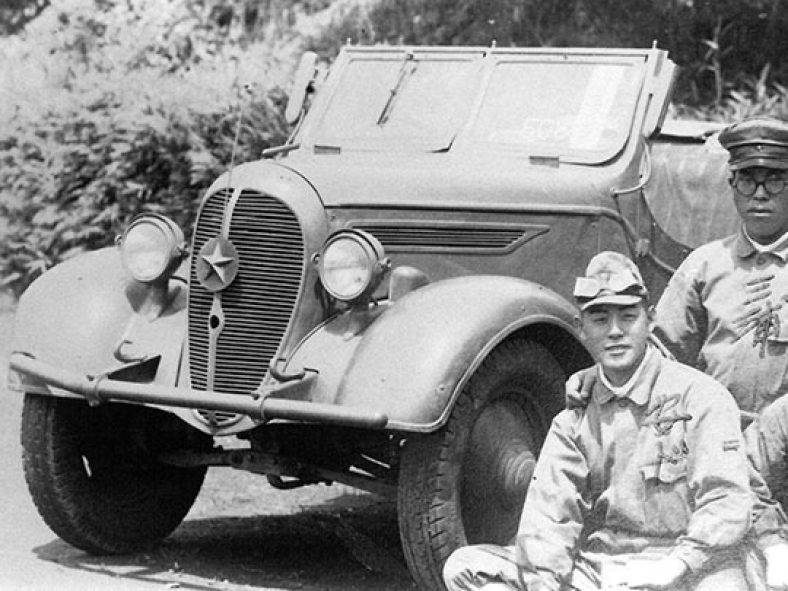
The very first Japanese Jeep
It is generally accepted that the first light compact reconnaissance and communication vehicles of the 4x4 type were designed and put into production in the USA. It's a delusion.
Long before the outbreak of World War II, Japan was already highly militarized and the technical equipment of its army was given increased attention. In 1935, the Japanese motorcycle company Rikuo Nainenki, commissioned by the military, developed a compact four-wheel drive vehicle with a length of 3 mm and a passenger capacity of 380–2 small people.
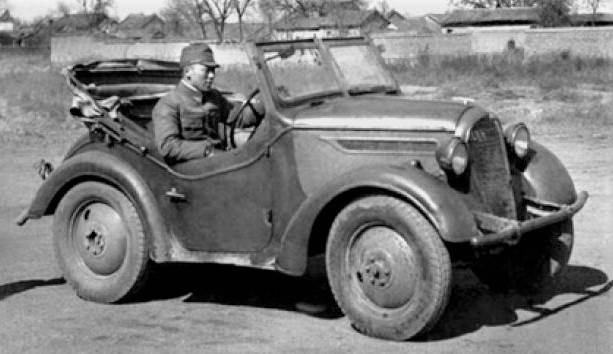
Its release began in the same year at the production of another motorcycle company, Nippon Nainenki Seiko. It received the name Kurogane (Steel) and the army index Type 95.
The car had a frame carrier system, an independent suspension with springs was used at the front, a rigid axle with a split crankcase, suspended on longitudinal springs, was used at the rear. The drive to the front wheels was organized by cardan shafts with Hooke's joints, which did not allow them to turn at a large angle and, as a result, worsened the agility of the car.
Large 18-inch wheels provided a ground clearance of 230 mm.
The two-cylinder v-shaped air-cooled overhead valve engine (with a dry sump) developed 33 hp. With. and ensured the acceleration of a jeep with a gross weight of 1 kg to 250 km / h, which at that time was more than enough.
The engine, sequential gearbox (3 lanes forward and reverse) and a single-stage gearbox were combined into a single power unit. Gears were switched by moving the lever in one plane either forward or backward. The front axle was connected with a separate long lever.
The car had amazing fuel efficiency for a jeep - only 4 liters per 100 km. But, of course, that it was an indicator for the highway.
Until the end of 1944, 4 Kurogane were produced.
So it can be quite reasonably stated that the type of army vehicle, later called a jeep, was the first to come up with and put into use the Japanese.
Post-war Japanese jeeps of their own design
After the war, Japan's economy was in a severe decline, but the automobile business began to improve little by little.
Capitalists are unprincipled people, for them business is more precious than honor. And after the Second World War, Japanese auto businessmen, wanting to please their new American friends, quickly forgot that they recently, for the sake of experiment, razed two large Japanese cities from the face of the earth with atomic bombs in a few seconds. And they mastered the assembly of overseas "Willis" and "Dodge" from car kits for the needs of a large contingent of occupying American troops stationed on the islands.
The impetus for the development and production of their own jeeps was a competition announced in 1950 to select the best light reconnaissance vehicle, which at that time was already called the collective term "jeep". According to one version, it was started by the command of the American military corps stationed in Japan, which urgently needed local cars for the war in Korea. According to another, the jeeps were needed by the resurgent Japanese army, modestly called self-defense forces.
And in 1950, three Japanese automakers at once: Nissan, Toyota and Mitsubishi, simultaneously stirred and brought to light small all-wheel drive military vehicles. It is understandable, a large state order could ensure the prosperity of the company for many years, so local automakers entered into a fierce battle for such a tasty morsel.
Nissan presented the military with a self-designed car, which received the 4W-60 index, which was a copy of the American Willys MB jeep, even the mechanism for folding the windshield of the cars was the same, and the Japanese steering wheel was also located on the left. The Japanese differed from the American only in the shape of the "grill" with horizontal slots, and the length of the steps.
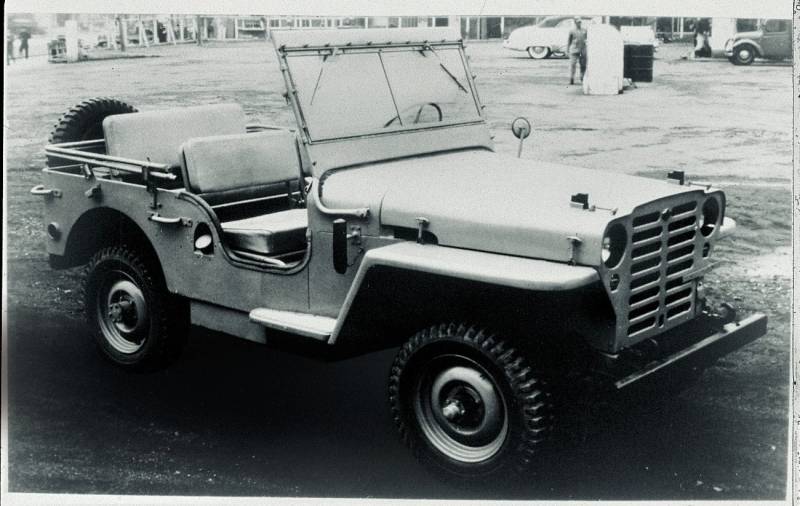
Nissan 4W-60
Toyota engineers offered for testing a prototype developed in 1950 in 5 months, which at that time did not yet have its own name and was designated by the index J, that is, Jeep. He also looked a lot like the American Willys MV, and even the “grill” of the car had nine vertical slots, like the “Willis”.
But there were also differences: the headlights were mounted on the wings, and the steering wheel was located on the right, and the engine was more powerful than that of the American, a 6-cylinder of its own production (Ne = 85 hp). Even before the war, it was used on Toyota cars and trucks and traced its lineage to the Chevrolet engine of the early 30s.
The basis for the development of the jeep was the chassis of a small truck, so its wheelbase was noticeably longer than that of its competitors.
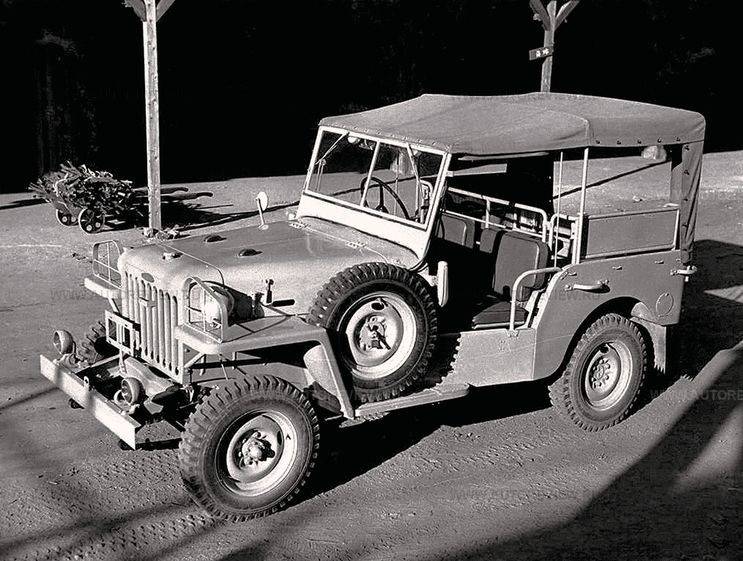
Toyota J
But the cunning marketers from the Mitsubishi company jumped all over. While two other Japanese firms submitted their own jeep-like developments to the competition, Mitsubishi rolled out real American jeeps, which the company assembled in its production from car kits coming from the USA.
Needless to say, the US military refused to purchase local home-made products of dubious quality and preferred to accept into the army a well-proven production model of an American off-road vehicle.
And in 1953, Mitsubishi managed to buy a license to produce a jeep model CJ3B (M606) from Willys Overland, which had entered a financial impasse. And she arranged its release under her own emblem with three diamonds, calling the modest name Willys, which was kindly announced by 6 Latin letters stamped on the radiator lining above the seven air vents.
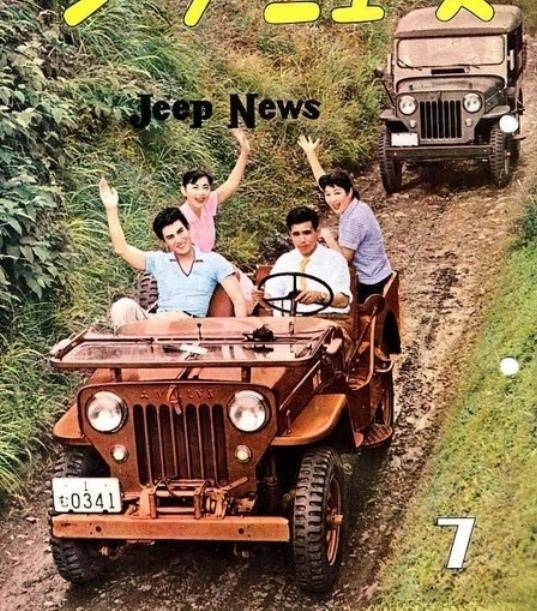
Mitsubishi Willys
And made it (hold on tight) for 30 years!
And in 1977, on the basis of this machine, its own modification was developed with the right-hand drive "Type 73" (J25А), which was in production right up to 1999 and was called Jeep.
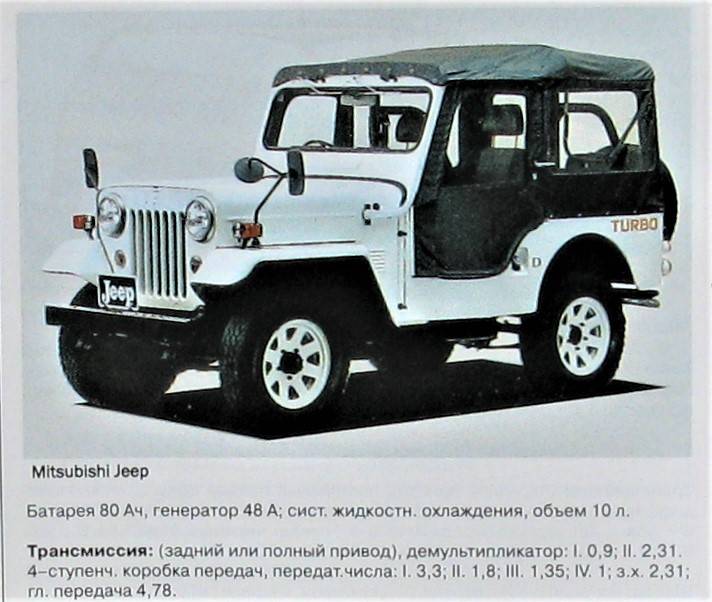
From the foregoing, it is obvious that the old "Willis" was a role model in the development of the first post-war Japanese jeeps.
Further development of Japanese jeep models
The failure at the competition greatly upset the management of Toyota and Nissan and cast doubt on the feasibility of further production of cars of this type. Severe Japanese designers were about to commit hara-kiri, but, fortunately for them, and as it turned out, for the happiness of motorists around the world, local police forces showed interest in the prototypes, who also desperately needed compact off-road vehicles.
Due to this circumstance, since 1951, Toyota began to slowly assemble its jeep developed in 1950, assigning it the BJ index, and gradually began to sell it to the Japanese police and firefighters. The car eventually received the name Toyota Jeep BJ.
In 1955, the second generation saw the light with a wheelbase shortened to 2 mm. At first, the symbols in the designation of the new car were BJ285, later jeeps began to be produced with a different, more powerful engine and went under the FJ2 index.
The letters B and F denoted the models of the installed engine, J meant Jeep (in this case, a compact car that can be used off-road), and the number 2 - the second generation of the model. Subsequently, this feature of the formation of the index of jeep models has become traditional for Toyota.
Some cars were made with a right-hand drive and intended for the domestic market, others had a left-hand drive and were exported. Export cars and received the later world-famous name Land Cruiser (land cruiser).
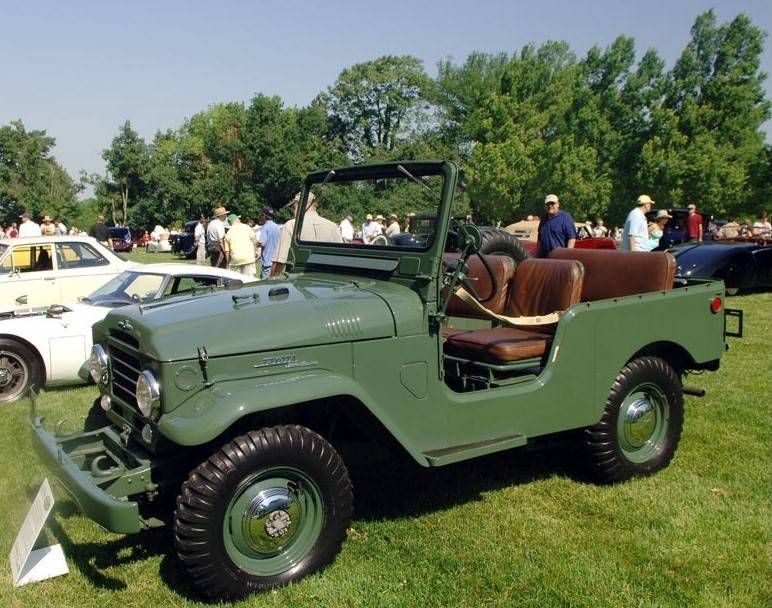
Take a closer look: in front of you is one of the first Land Cruisers.
In those years, the English Land Rover spread across all continents, here the cunning Japanese, aiming at export, came up with a consonant name for their “SUV”, you see, someone will mistakenly confuse and buy it.
However, according to the official version of the Japanese company, the first generation cars were named after Land Cruiser back in 1954. I don’t want to offend anyone, but personally it seems very doubtful to me: it’s unlikely that a small company that produced only 1953 BJ cars by 289, some of which managed to sell to the local police forces, in 1954 already had ambitious plans to promote its jeeps around the world, for which it was urgently necessary to come up with a sonorous name for the car. And no matter what they say, but the Land Cruiser sign first appeared on the side of the hood of the second generation models, and not the first.
And some evil tongues chatted that in 1954 the powerful corporation Kaiser Industries, which bought out the dying company Willys Overland in April 1954, expressed serious claims to Toyota for the unauthorized use of the word Jeep in the name of the BJ model, which the Americans, not without reason, considered their property. Not wanting to quarrel with powerful friends, the Japanese began to urgently look for a new name for their car, and as a result they came up with the phrase Land Cruiser, which they dubbed the second generation cars.
Nissan also did not sit idly by and in 1951 began mass production of the 4W-60 model shown to the military. The car, like the Toyota BJ, was produced with an open top without doors and was equipped with an easily removable fabric awning. In August 1955, small updates were carried out: chrome strips appeared on the hood and radiator lining, the front seats changed, and most importantly, a new 4-liter engine with 105 hp was installed. With. The models were assigned the index 4W-61.
And in October 1958, a significant event took place: another update was made, the new jeep received the 4W-65 index and, most importantly, acquired the Patrol nameplate located on the side of the hood, which it never parted with again.
Thus was born the legendary Patrol.
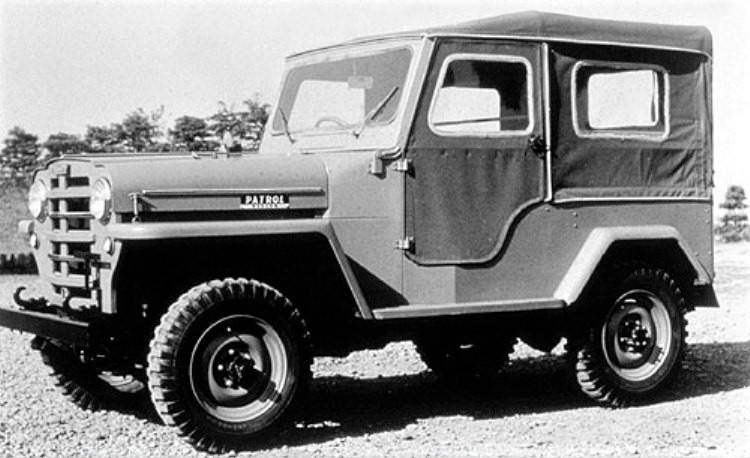
Patrol 4W-65
As the decades passed, Nissan, Toyota and Mitsubishi gradually increased the size of their all-wheel drive vehicles as they changed generations. Some of them eventually ended up in the armies of various countries and even became part of the UN peacekeeping forces.
But most of the produced cars of this type went into commercial sale, so over the years they became more spacious, more comfortable, and soon it was no longer correct to call them jeeps.
And the word “jeep” itself gradually lost its original meaning, and instead of a semi-official term denoting an army liaison and reconnaissance vehicle, it began to personify an ordinary “civilian” vehicle on large wheels with increased ground clearance and a strong undercarriage that could be used for a short time on a light off-road.
similar to a jeep
In addition, it is necessary to mention one more model, which many call the Japanese jeep.
In 1970, Suzuki launched a small four-wheel drive car with a frame carrier system and high ground clearance, called the Jimny, to the Japanese car market. This name was the fruit of a misunderstanding: at first, marketers came up with the name Jimmy, but at the stage of final agreement, someone mixed up the letters and wrote n instead of the second m. The result was Jimny.
Another name for the little car was royally proud - Brute IV. The model had an index LJ10, the letters meant the phrase "light jeep".
The car was 3 mm long and 000 mm wide, making it even smaller than the first Japanese jeep Kurogane. Weight was 1 kg, passenger capacity 300 people, load capacity 590 kg. The center drive was the simplest blocked with a front plug-in axle. The machine was driven by a 3 hp air-cooled two-stroke motorcycle. With. at 250 rpm (apparently according to JIS). A spare wheel served as a headrest for one of the passengers.
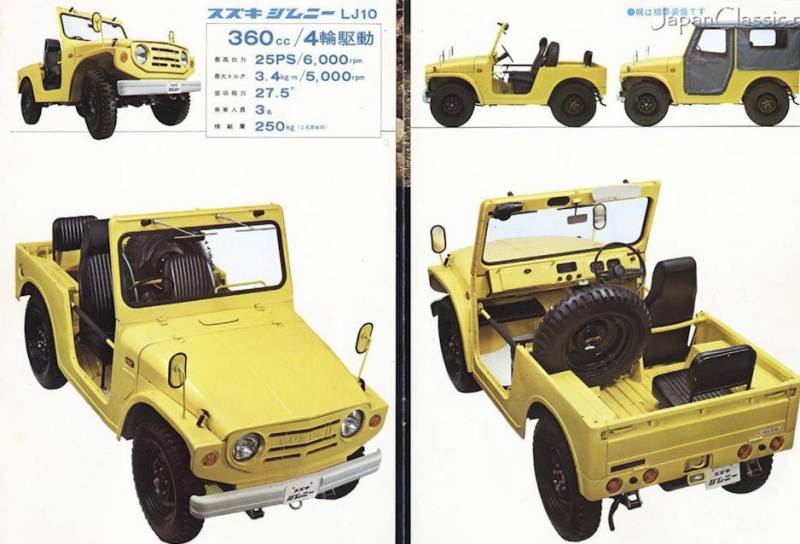
Jimny
The first buyers of this miracle of Japanese technology were not the military at all, but ... an electric company that purchased this vehicle for its fitters who check electrical cables. So, in fact, it is not correct to call this model a jeep, in fact it was a special equipment, which later evolved into a youth car for outdoor activities.
And the LJ10 is curious only because it was the ancestor of a large family of compact off-road vehicles that spread around the world and was produced in various countries of Europe and Asia, which, with the appropriate color, became similar to army jeeps.
According to autohistorian E. D. Kochnev, Suzuki never produced cars that subsequently entered service with any army in the world. So the claims of some proud owners of these machines that their Jimny or Samurai have "military roots" is an exaggeration.
But from ascertaining this fact, our respect for their personal courage does not at all diminish ...
Used Books:
Kochnev E. D. "Military vehicles of the Wehrmacht and its allies", M., Yauza, 2009.
Fiala Jiri "Off-road vehicles", LLC "Labyrinth Press Publishing House", 2006.
Information